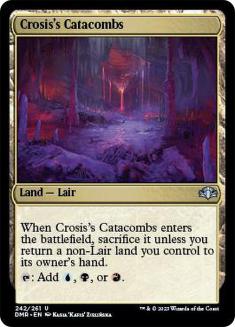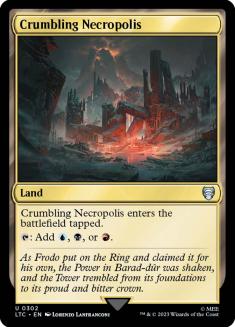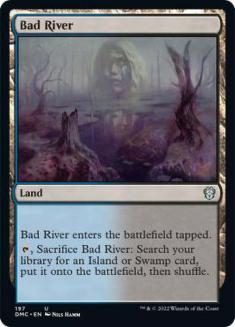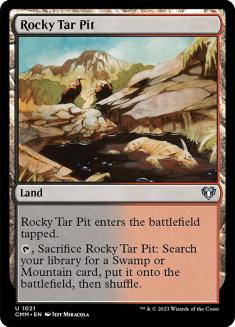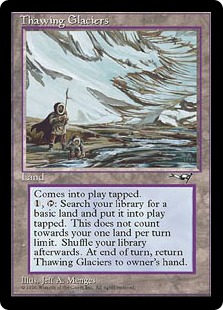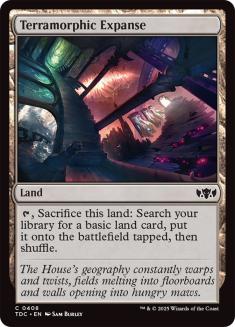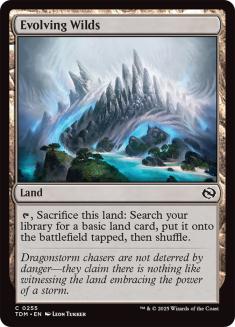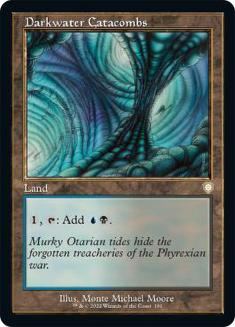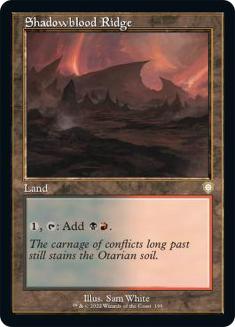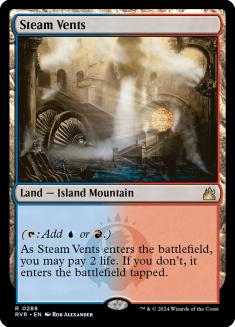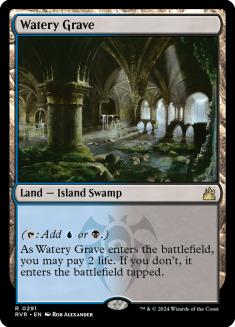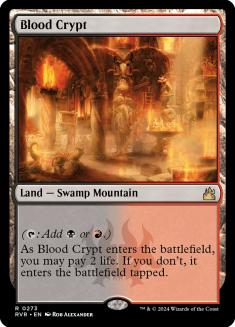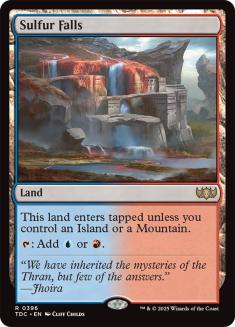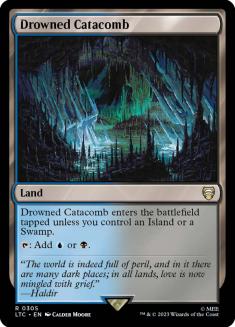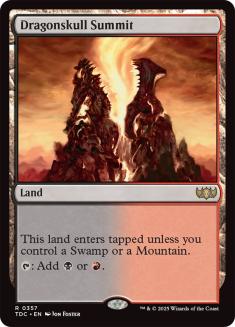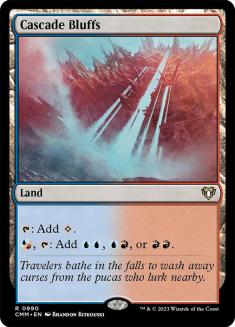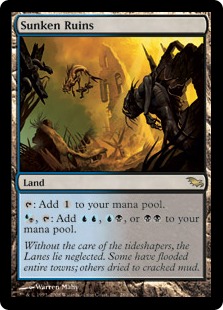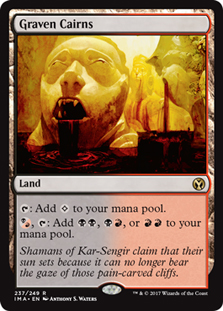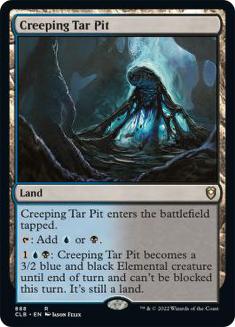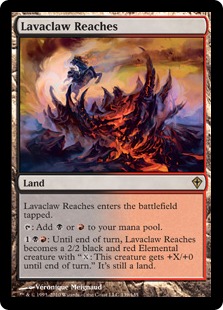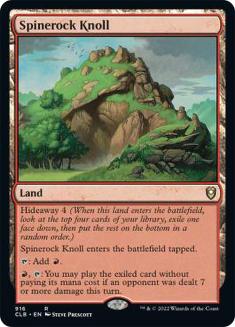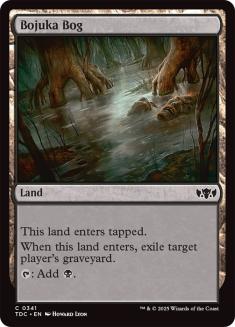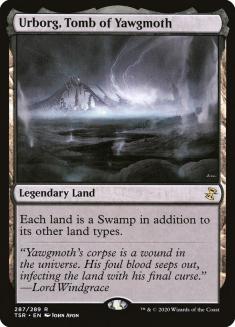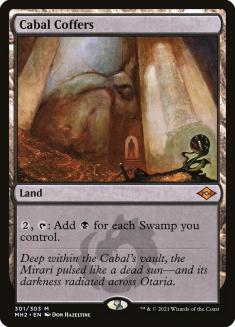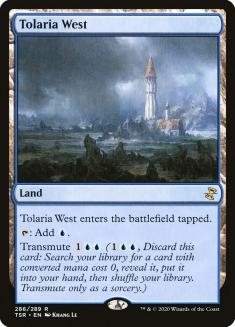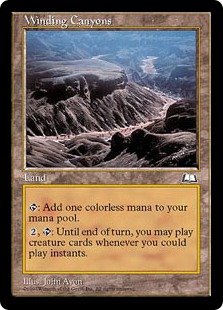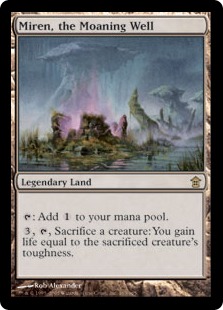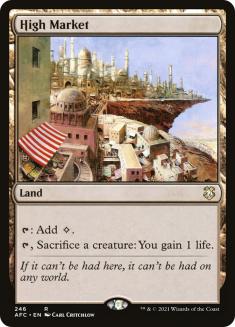With the release of the new multiplayer-draft-wackiness expansion Conspiracy, a lot of people who may not usually do so have gotten their draft on
this weekend. The format is incredibly fun and bends the brain with all the oddities and complexities it layers on top of normal drafting and normal
multiplayer, but as far as things that are relevant to the readers of this column, it also brings with it a whole slew of new multiplayer-oriented
cards… and a few new Commanders to boot! This is not going to be a Conspiracy set review for Commander – that will be appearing elsewhere soon. This
isn’t even a comprehensive review of all five legendary creatures in the set with sample decks for where you might want to explore if you were to build a
new Commander deck around them. In this article, we’ll be taking a close look at just one new Commander to see what interesting places she takes
us.
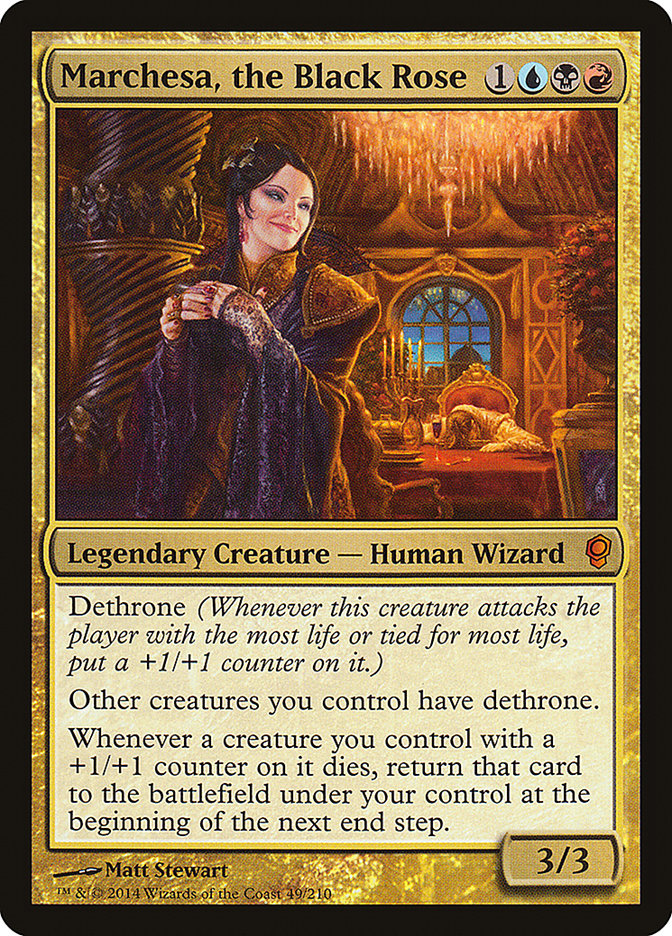
I have a long-standing fascination with Grixis commanders, and Marchesa has an awful lot to offer – especially if you pursue her dominant themes. Let’s
take a closer look:
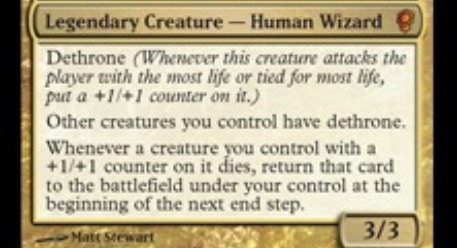
Marchesa lets us build an aggressive deck that will actually be able to hang with the bigger creatures you see later in the game thanks to the fact that
your turn 2 play will start growing larger from turn 4 onward, gaining a +1/+1 counter a turn. She also adds a considerable bit of resilience, especially
if you follow a “+1/+1 Counters Matter” theme – creatures that naturally enter the battlefield with a +1/+1 counter on them will perpetually return to play
thanks to Marchesa’s ability, meaning we can have an awful lot of fun with anything that lets us sacrifice creatures for fun and profit. Better yet,
Marchesa’s ability triggers on any creature we control, not own, returning them to play on our side of the board no matter whose card it
actually is – we can get a lot of mileage out of cards that borrow resources from someone else, then, since anything we can borrow and then eat becomes
ours for real.
Marchesa offers a lot of angles to build around, so let’s see where we end up once we start exploring that play space!
The Lands
This is not going to be a deck where our manabase is very interesting, alas. We’re going to gain some spell-like benefits out of it, it’s true, but unlike
a lot of the decks I tend to see in Commander, we’re not going to be able to get that much bonus use out of our lands besides providing mana – we
want to be able to play all of our cards early in the game, since we’re going to go with a tempo angle at the early stages, which means we can’t fit quite
as many interesting things like Mazes without their costs potentially hindering our play. I like to get a fair bit of card advantage from my manabase but
Ravnica bouncelands will interfere with our early plans, while too many colorless lands will stop us from hitting our initial creature drops on-time.
Weighing the need for good mana against the costs it takes to achieve that, we get the following:
Plus:
3x Mountain
3x Island
3x Swamp
Proliferating For Fun And Profit
Marchesa offers us an incredibly easy vector to follow – there should be +1/+1 counters on all of our creatures, so any Proliferate effect basically acts
as a Glorious Anthem effect, helping to build our initially-small creatures into a formidable fighting force and stay bigger than the creatures our
opponents will be playing in the more-relevant five-, six-, and seven-drop range as the game settles into its normal range. This means we’re going to play
some funky cardboard, which is one of my favorite parts of exploring the format, in addition to following the someone-boring “+1/+1 Counter Matter” tribe
available to us in Grixis colors.
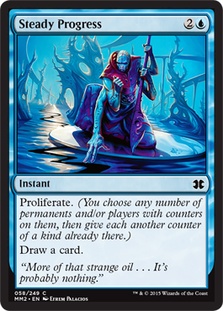
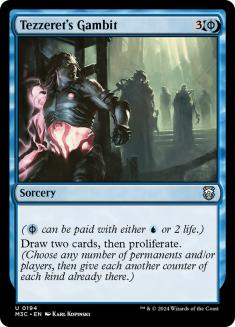

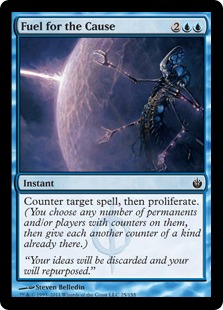
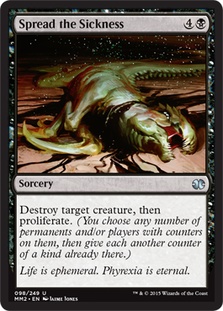
One-time Proliferate effects come with a lot of value added to them in this deck, so we should hardly notice that Steady Progress does nothing besides
replace itself and Proliferate – that three mana is spent to generate a useful effect, and should effectively allow us to play a mid-combat Glorious Anthem
if we want… and draw a card while we’re at it. The only one that is dubious is Spread the Sickness, because five is a lot of mana to pay for a removal
spell of this sort when we could get a comparable effect at instant speed for anywhere from zero to two mana depending on how much life we want to pay or
what other hoops we want to jump through (like Slaughter Pact’s somewhat-awkward trigger), but staple Proliferate to anything and it gets a lot more
interesting.
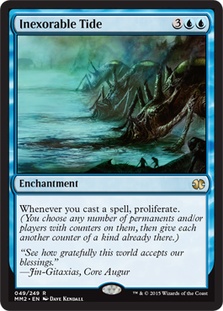
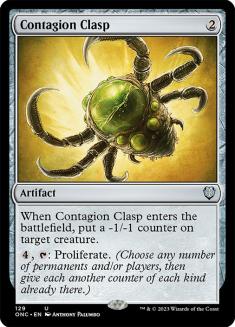
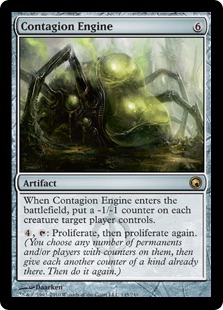
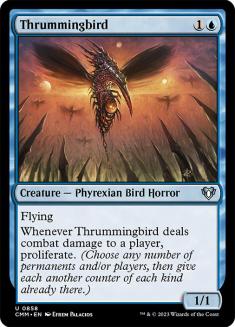
I do not usually appreciate the often-underwhelming Thrummingbird, but here, its trigger can reliably turn on as early as turn 4 with something worthwhile
to get out of it – even if it’s just something small like putting a second +1/+1 counter on the bird itself, possibly a second counter on a second creature
while we’re at it. It’s usually a bad fit in most of the decks that try to use it, but here it might just be an all-star thanks to Marchesa’s ability to
put counters on your entire team turn after turn. All four of these let us Proliferate turn after turn instead of generating single-use effects like the
cards above, which can give us some staying power if our early rush gets outclassed or eats a Wrath effect. Those things are fairly common, and while
Marchesa provides some built-in Wrath defense with her triggered ability, we still need something to let us catch back up afterwards – and putting some
mana into a Contagion Engine is a great way to turn your small creatures back into big ones.
Mindless Automaton – Talk about the perfect fit for this deck! In addition to letting you cycle through dead cards to get deeper into your deck or convert
attack phases and Proliferates into card draws, you can get bonus draws out of this very easily by adding in sacrifice effects or even just getting blocked
in combat. While it doesn’t go completely nuts – if you sacrifice those counters and turn the Automaton into a 0/0, Marchesa won’t see it as a creature
with a +1/+1 counter on it – it goes pretty crazy very quickly and lets us get paid back for playing our specific Commander.
Thopter Squadron – Another way to make a profit so long as you have a sacrifice outlet, Thopter Squadron can make two free fliers before being sacrificed
and come back to make even more. Those creatures will of course be perfectly valid for Marchesa’s ability to grow, letting us profit just by managing our
resources carefully.
Triskelion – Triskelion provides two free damage per time you manage to sacrifice it, or just an ever-growing creature that gets bigger with each attack
and stores up extra damage turn after turn while we’re at it.
Triskelavus – This is what happens when you marry the above cards to each other, letting us make more fliers and/or get more pings as we save up – don’t
laugh, it works.
Taurean Mauler – While it does not have +1/+1 counters innately, it will basically always have a counter, making it effectively indestructible
with Marchesa around in addition to normally being a three-mana 7/7 (or larger).
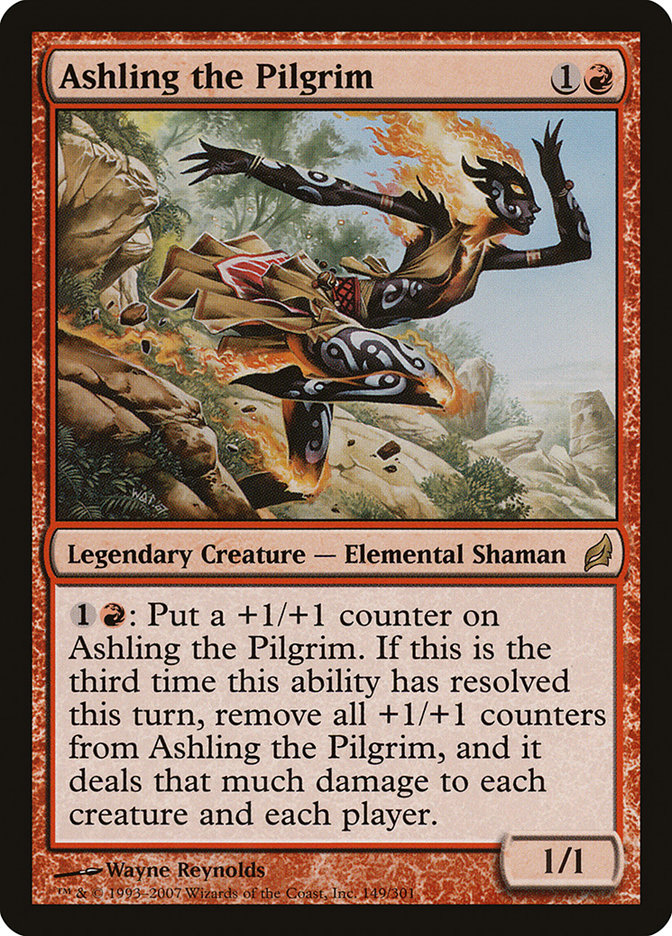
Ashling the Pilgrim – Counters now turns into damage later, and an active Ashling threatens to potentially deal a pile of damage and perform a
one-sided Wrath effect thanks to Marchesa returning your team to play at end of turn. This deck is going to get a ton of value out of its
two-drops, and this particular one is so good that some people play her as their Commander with just 99 Mountains.
Cosi’s Trickster – Like Taurean Mauler, this doesn’t start with counters naturally but can develop them at an astonishing rate. We’re building a beatdown
deck, which means we’re building around the hope of curving out in the early game, so this will either be a one-drop or fit alongside a second two-drop on
turn 3 and start to go large with Marchesa in play.
Carrion Feeder – This provides us both a +1/+1 counter source and a sacrifice outlet, letting us pull off shenanigans if we want to by re-using
nay of our creatures or potentially keeping anything we’ve managed to borrow. We like this effect enough to want it on all sorts of different cards, and
that this comes with access to +1/+1 counters and can beat down on-curve is just an amazing bonus.
Tar Fiend – Another way to potentially eat creatures for fun and profit turn after turn, so long as you can sacrifice your Tar Fiend you can potentially
devour as many things as you want each turn and get all of them back so long as they had +1/+1 counters on them. While we’re at it, it can also knock a
considerable amount of cards out of an opponent’s hand, stripping the opponents of vital resources turn after turn.
Oona’s Blackguard – Another way to get paid back for the +1/+1 “tribe,” Oona’s Blackguard can start working on opposing hands as early as turn 4 and can
quickly grow out of hand thanks to Marchesa’s ability distributing counters to every creature on our side of the board. We don’t need to actually find more
cards for the Rogue tribe, because Marchesa lets everyone team up!
Sage of Fables – Like the Blackguard, this puts our +1/+1 counters to work in an interesting new way – but instead of stripping an opponent of their
resources, Sage of Fables lets us generate more of our own. And Wizard is a much more common tribe in this deck, including our Commander, which potentially
protects her from the very moment she enters play with her own triggered ability.
Molten Hydra – Another cheap creature we can play early on and grow into something interesting, the Molten Hydra saves up damage for later and can
potentially be used to take out multiple utility creatures over the course of a game. Be careful removing that last +1/+1 counter, though, as you will need
either three spare mana or another attack phase while it’s small to gain back Marchesa’s protection ability.
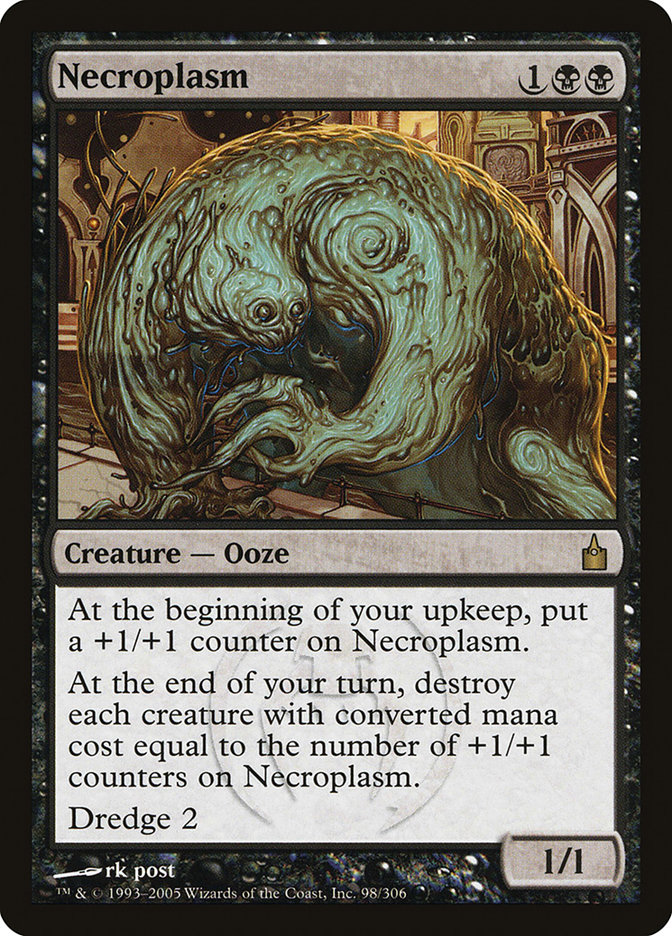
Necroplasm – The problem with Necroplasm, usually, is that it kills itself when you want it to get past three counters and start killing the opponents’
creatures exclusively. With Marchesa online and any number of Proliferate effects available to us, as well as creatures that don’t really mind if
they die to its triggered ability, Necroplasm can provide us with some very high-powered removal so long as we’re able to time its use carefully with
Dethrone triggers, proliferate effects, and sacrifice effects as-needed.
Stingmoggie – Every time I’ve seen this card considered – even for draft – that name has started off “Stink” instead of “Sting.” But this normally-correct
value judgment is turned on its ear when you can recycle it or build it up as easily as we can, letting us have access to another effect that removes
artifacts or pesky lands from play pretty easily turn after turn. Your opponents will tell you this card is terrible, but sometimes terrible cards can own
a table – that’s Commander for you!
Olivia Voldaren – Source of +1/+1 counters? Check. Bonus removal for our somewhat removal-light deck? Check. Interesting way to gain control of an
opponent’s creatures and thus potentially use Marchesa’s abilities together in order to make it a permanent addition to the team? Olivia is the full
package, as far as we’re concerned, though she’s mana-intensive for what we’re trying to accomplish.
Grimgrin, Corpse-Born – Another sacrifice outlet in addition to another removal source, plus the +1/+1 counters side working well with Marchesa. Like
Olivia, Grimgrin hits a lot of our major themes and will fill multiple roles while dominating the table, working even harder in this deck than it probably
would in a Commander deck at which it was at the helm itself.
Goblin Razerunners – A bit of a stretch, yes, but not every creature with a potential +1/+1 counters theme is going to be perfect. Goblin Razerunners can
pile on some additional damage after-the-fact, letting us manipulate who is at the highest life total for future Dethrone triggers, or can even just finish
off someone who’s on their last legs so long as you have a few lands you don’t really need hanging around.
Deathbringer Thoctar – Speaking of ways to kill off beleaguered opponents, Deathbringer Thoctar gets a +1/+1 counter every time something dies – which we
can trigger over and over again fairly cheaply – and can convert these triggers into extra damage in addition to extra power, machine-gunning down opposing
small creatures basically for free and taking down weak opponents with a barrage of spent counters. This particular addition gives us something of a
combo-like feel if we want to go that direction, but that combo is ultimately a fair one even if it is also potent.
Sphinx of Magosi – We are somewhat light on card-draw, and this can gain +1/+1 counters at-will while granting us the ability to turn extra mana into extra
cards instead. While it’s not especially strong even in this deck, it’s at about its strongest here compared to anywhere else I’ve ever seen it, and fills
a much-needed role by allowing us to refill when we’ve run out of resources.
Maga, Traitor to Mortals – Sadly, this would come back as a 0/0 if we tried to sacrifice it and work it harder, but it does give us the ability to knock a
player out from a low life total or change which player we’re rewarded for attacking if we play it before combat. This will basically only be good as a
finisher (and then only if we’ve assembled Urborg + Coffers), but its power, if we get there, is quite strong.
Supporting Cast
Not every creature is going to have an angle it can work by itself with the +1/+1 Counters Matter theme standing in for our tribal vector. They can all add
themselves just by attacking, though, so we’re going to pick other creatures based on their comes-into-play abilities or other benefits they may provide us
that fits into our overall game-plan.
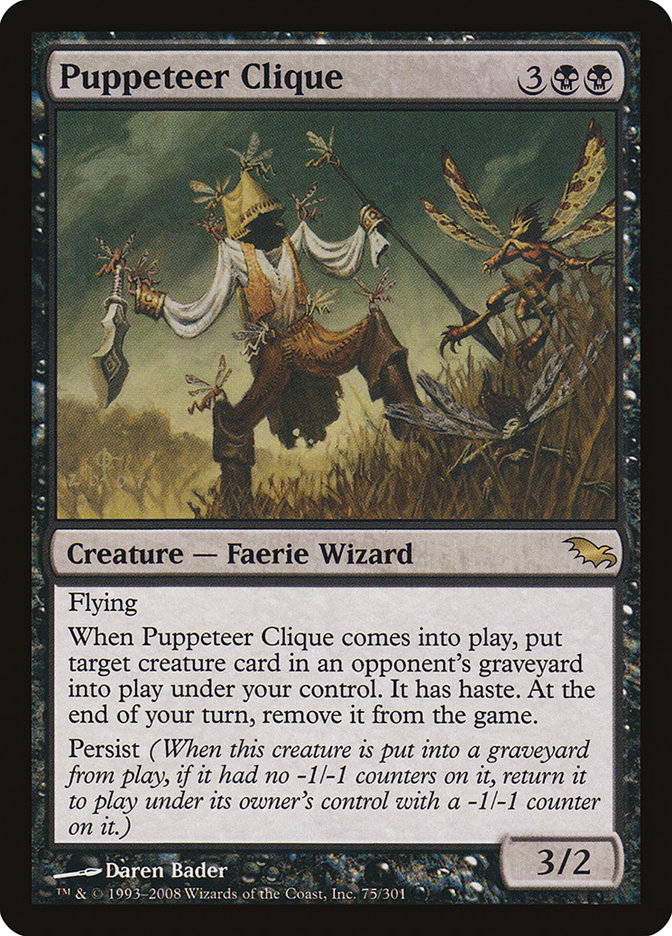 Puppeteer Clique is basically everything I like doing in Commander – it’s resilient, can lead to amazing turns when
Puppeteer Clique is basically everything I like doing in Commander – it’s resilient, can lead to amazing turns when
you kill opponents out of nowhere, or can even sacrifice itself to set up a mid-combat trick that seriously changes the flow of the turn. Puppeteer Clique
is a different animal in this deck, however – Marchesa lets us reuse the ability by resetting the -1/-1 counters that Persist inflicts upon us, granting us
additional uses of this powerful trigger, and if we’re able to steal something, get a counter on it, then sacrifice it instead of waiting for Puppeteer
Clique to exile it at end of turn, we get to keep it! A card I already love and craft late-game turns around maximizing has so much additional depth and
value thanks to our Commander’s abilities, meaning we get to take my favoritest thing and turn it up to eleven.
Furystoke Giant – Marchesa cares about damage, and Furystoke Giant provides damage. Like Puppeteer Clique we’ll be able to get multiple uses out of this
ability if we go about it the right way with Marchesa, meaning we can use this over and over again for board control or to play kingmaker by changing who
is on top of the throne that she cares so much about.
Trinket Mage – Supporting roles are important too, and we can use this to get a sacrifice outlet, Sol Ring or Sensei’s Divining Top as well as a few other
utility and power cards. We can even access any land out of our deck through this trigger, and can potentially use it multiple times thanks to Marchesa.
Not every support card has to have a massive impact, the small edges a card like this provides will build up as we play our game normally and can
potentially assemble a very strong board position by getting multiple uses out of the enters-the-battlefield trigger.
Solemn Simulacrum – Talk about cards that provide a huge advantage if we’re able to use them multiple times! Solemn Simulacrum can get us a land and a card
every time we’re able to get a counter onto it and then sacrifice it, letting us refill our hand and build up our mana at a considerable rate. It’s good in
every deck where you have a basic land that it’s allowed to find, but it’s working even harder than usual for us.
Nekretaal, Shriekmaw, Bone Shredder – While none of these is “perfect,” each can potentially provide a reusable source of pinpoint removal for our deck
that is otherwise pretty light on it. Marchesa lets us put a counter on and then get a second use out of any of these, making them stronger than their
usual selves here in our deck. I normally only consider Shriekmaw “good enough” to make the cut in Commander, but here each of these fills a specific need
and is better than they look thanks to Marchesa’s beneficial abilities.
Zealous Conscripts, Conquering Manticore, Dominus of Fealty – Anything we can lay our hands on, we can potentially get a counter onto and then sacrifice to
get to keep it. And anything that provides that sort of an effect while itself being a creature we can potentially get a +1/+1 counter on, well, that just
lets us potentially go bonkers and build up a dominant position where we can steal and then permanently keep pretty much anything that gets in our way.
Zealous Conscripts even has haste, so it has an easier time than most putting a +1/+1 counter on itself in a timely fashion, plus it can steal things
besides creatures if other types of permanents are what is getting you down.
Support Spells
The bulk of our deck has been fleshed out, with 76 of our 99 slots filled by mana and things that work well with Marchesa’s +1/+1 counters tricks. We have
some other needs to fill, however – we need to protect our board from key problem spells resolving, we need Trinket targets if we’re going to expect that
to do anything and we need some more sacrifice outlets if we can get them because we really want to make sure we draw one each game. We would also like to
note that Marchesa’s ability effectively turns off if we are the player with the highest life total – even if we’d like to, we can’t attack
ourselves, so having a few cards that allow us to pay life in order to generate a powerful or beneficial effect will help keep our engine running. This
means I’m going to include a card I basically never touch, and do not even own a copy of for my Big Commander Deckbuilding Box Of Doom…
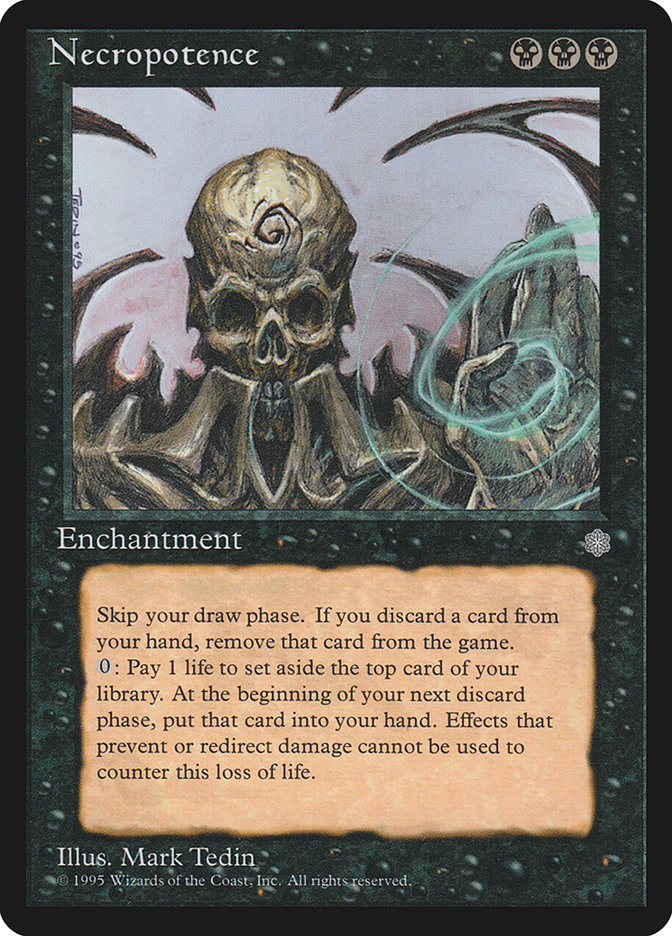
We cannot possibly understate the powers of The Skull. Talk about an unfair card – so long as you have life to spend, and can accept a mild time delay, you
can trade life one-for-one each turn in order to get as many cards as you want. Fill up your hand? Sure! Dig twenty cards to find the right answer to the
problem in front of you? If you’ve got the life to spare, we can do that too! We need to be able to moderate our own life total if we gain an advantage on
the board and start to pull ahead, so that we can make ourselves #2 and still get paid off for attacking the new #1. There is no better way to do that than
by casting Necropotence, so even though I usually loathe to include it, there are few replacements for the aspects it provides us.
Phyrexian Reclamation – One of those replacements is this card, and because we actually care about hitting our own life total, it’s worth noting that we
can activate it multiple times in response to each other if we only have a single creature card in our graveyard. These are the kinds of crazy things that
can only happen when something odd is going on, but Marchesa cares so much about life totals that sometimes it will be worth blackening our own eye in
order to get paid to cut another opponent down to size.
Demonic Tutor, Increasing Ambition – So long as we’re playing black, we might as well benefit for it. I usually find I’ve drawn one half of the Urborg +
Coffers combo and use Increasing Ambition to find the other, suddenly making its Flashback cost ‘free’ and giving us two cards of our choice in our hand
plus a whole lot of mana to use on them next turn. I don’t really want a lot of tutors in this deck – we don’t have all that many individual cards with
effects that are absolutely unique and thus no strong desire to hunt them down specifically instead of just draw more cards so we draw something that fills
that much-needed role – but the first two tutors can be included in good conscience without making it so that you’re touching your deck all of the time to
find the right oppressive card to shut down the board.
Grave Pact, Dictate of Erebos – Speaking of things that are oppressive and shut down the board, we’re really good at sacrificing creatures for
free and not really noticing that doing so has a cost. Both of these can keep the opponents from assembling a credible force to defend themselves with or
attack us for lethal, and deserve to be killed on sight (and presumably will be). While we have them, though, they’ll do a lot of work sweeping the
opponent’s board, and thanks to Marchesa we’ll basically be able to keep our own even as we do so.
Decree of Pain – Sometimes you need to kill every creature in play and draw a bunch of cards. Decree of Pain is excellent for those times, and thanks to
our Commander, once again, we’ll usually be left with everything we started with so long as we’re able to plan it out right.
Hinder, Spell Crumple – A little bit of countermagic goes a very long way. Some Commanders are so powerful that we need a permanent answer to them, which
both of these provides, and I like being able to play a longer game with a piece of countermagic up to defend my board position and keep specific threats
in play. I don’t want a lot – we’re playing exactly three, because we value the first one but not really any subsequent ones – but this lets us access a
little bit of board control as we get to the later stages of the game where opponents’ cards can easily expect to be more powerful than any of ours.
Insurrection – Speaking of, this is exactly the sort of thing we’re talking about here. That it happens to put every creature onto our side and potentially
lets Marchesa trigger for all of them, then let us sacrifice them somehow for fun and profit, well… that’s almost secondary to the fact that this
resolving tends to kill most tables. It just happens to be extra good at that in this configuration, since you can take down one player and gain control of
everyone else’s creatures while you’re at it, so the mid-game weak Insurrections that are profitable but don’t end the game will still be very worthwhile
for us.
But usually it just kills everyone, and that’s still going to be true. We don’t have a lot of high drops, but the ones we do have are all going to be like
this.
Grab the Reins, Word of Seizing – We can get a lot of value out of temporary gain-control effects, since if we time them right we’ll be able to claim
permanent ownership of whatever card we’re borrowing. We only really have room for two of this effect in addition to the creatures we’re using to build up
this aspect of the deck and the tutors that can let us find a copy when we need one, and these are the best two there are for the job. Honorable mention
however goes to newcomer Harness By Force, which could potentially let us go a little bit crazier than usual if we wanted to target multiple creatures with
the spell – both of these win out because being an instant really is just better, and the Split Second side of Word of Seizing and the Entwine side of Grab
the Reins are both better than the multikicker side of Harness By Force. If we had room for one more, it’d be in, but we have some careful balances to
maintain as we build the deck to work in multiple ways and from different angles of attack.
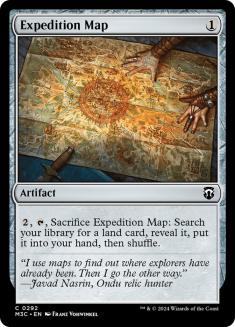
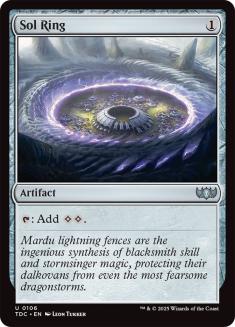
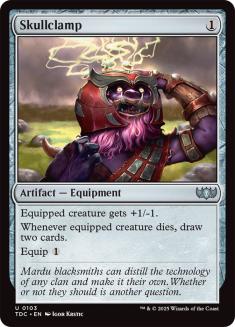
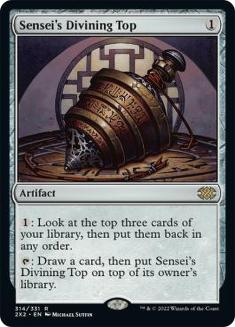
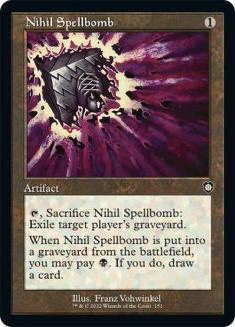
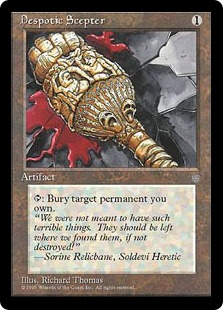

Our Trinket targets, some of them are obvious format-staples that we’d be happy to play otherwise but all of them are made that extra little bit better by
having another card that is able to tutor them up… and which can potentially get all six of them if the game goes long enough. We’re used to Skullclamp
going crazy and in this deck it most certainly does that, but the oddball Trinket addition of Despotic Scepter just goes to show that we are really
committed to things that are so dirty that literally no good can come of that for our opponents. Its text is literally “tap to destroy something nice of
yours,” and here we’re using it to re-use individual creatures with Marchesa’s abilities or even gain permanent ownership of something we’ve merely
borrowed. I have never seen anything good of any deck that has willingly played Despotic Scepter, and I look forward to getting up to some shenanigans with
it in play on my side of the board as well.
Oblivion Stone – Boring format staple is boring, and is present for the obvious reasons.
Lightning Greaves – Marchesa’s ability can only protect herself… or anyone else… if they get a +1/+1 counter on them. Lightning Greaves grants a bit of
protection from awkward targeted effects like Swords to Plowshares, it’s true, but we’re mostly just using it because getting haste lets a creature get a
+1/+1 counter the same turn that you cast it, which protects it from removal spells from there thanks to Marchesa’s trigger. Again, we don’t want to
overload on this effect, but the first one is very valuable to us.
Culling Dais, Spawning Pit, Helm of Possession – Our last three cards are sacrifice outlets, and they each have their own unique special abilities they
provide on the side. Spawning Pit can sacrifice multiple creatures a turn without tapping or needing mana, and can turn sacrificed cannon fodder into bonus
token 2/2’s later in the game, which means we can take advantage of Marchesa’s trigger in order to build a huge board presence with very little actual
cardboard or can go nutty with Insurrection if we draw both. Culling Dais is not something we really want to sacrifice, but with all of our Proliferate
effects we can reasonably expect to turn this into a draw-three or better over the course of an average game all while using it for its intended function
of sacrificing things for fun and profit, so sometimes this will just randomly draw us a new hand when we’ve run out of gas. And Helm of Possession is a
repeatable sacrifice outlet that also gives us control of opposing creatures, which Marchesa can then put a counter on and a second sacrifice effect (or
just normal death via playing Magic) will allow us to turn into permanent control over the card in question.
Putting it all together, we get the following:
Creatures (31)
- 1 Solemn Simulacrum
- 1 Triskelion
- 1 Nekrataal
- 1 Carrion Feeder
- 1 Bone Shredder
- 1 Trinket Mage
- 1 Thopter Squadron
- 1 Mindless Automaton
- 1 Molten Hydra
- 1 Maga, Traitor to Mortals
- 1 Necroplasm
- 1 Triskelavus
- 1 Ashling the Pilgrim
- 1 Shriekmaw
- 1 Oona's Blackguard
- 1 Sage of Fables
- 1 Stingmoggie
- 1 Taurean Mauler
- 1 Furystoke Giant
- 1 Puppeteer Clique
- 1 Dominus of Fealty
- 1 Tar Fiend
- 1 Goblin Razerunners
- 1 Deathbringer Thoctar
- 1 Cosi's Trickster
- 1 Conquering Manticore
- 1 Sphinx of Magosi
- 1 Thrummingbird
- 1 Olivia Voldaren
- 1 Grimgrin, Corpse-Born
- 1 Zealous Conscripts
Lands (37)
- 1 Cabal Coffers
- 1 Thawing Glaciers
- 3 Swamp
- 3 Mountain
- 3 Island
- 1 Crosis's Catacombs
- 1 Shadowblood Ridge
- 1 Darkwater Catacombs
- 1 Rocky Tar Pit
- 1 Bad River
- 1 Winding Canyons
- 1 High Market
- 1 Miren, the Moaning Well
- 1 Watery Grave
- 1 Steam Vents
- 1 Blood Crypt
- 1 Terramorphic Expanse
- 1 Urborg, Tomb of Yawgmoth
- 1 Graven Cairns
- 1 Tolaria West
- 1 Spinerock Knoll
- 1 Sunken Ruins
- 1 Cascade Bluffs
- 1 Crumbling Necropolis
- 1 Dragonskull Summit
- 1 Drowned Catacomb
- 1 Bojuka Bog
- 1 Creeping Tar Pit
- 1 Lavaclaw Reaches
- 1 Evolving Wilds
- 1 Sulfur Falls
Spells (31)
- 1 Sensei's Divining Top
- 1 Hinder
- 1 Necropotence
- 1 Sol Ring
- 1 Demonic Tutor
- 1 Grave Pact
- 1 Decree of Pain
- 1 Skullclamp
- 1 Oblivion Stone
- 1 Lightning Greaves
- 1 Spawning Pit
- 1 Grab the Reins
- 1 Insurrection
- 1 Despotic Scepter
- 1 Helm of Possession
- 1 Phyrexian Reclamation
- 1 Word of Seizing
- 1 Expedition Map
- 1 Contagion Clasp
- 1 Steady Progress
- 1 Contagion Engine
- 1 Inexorable Tide
- 1 Culling Dais
- 1 Nihil Spellbomb
- 1 Spread the Sickness
- 1 Fuel for the Cause
- 1 Tezzeret's Gambit
- 1 Volt Charge
- 1 Spell Crumple
- 1 Increasing Ambition
- 1 Dictate of Erebos

This was actually really fun – I’ve been trying to build something in Grixis for some time now, but have never really been happy where those three colors
combined to take me – but it is far from all Conspiracy has to offer us for Commander play. Conspiracy offers us four other interesting Commanders as well,
so if you’d like to see me or Cassidy take a crack at one of the other new ones, feel free to submit a decklist using the link below and we’ll consider
featuring it in an upcoming column!
— Sean McKeown
Want to submit a deck for consideration to Dear Azami? We’re always accepting deck submissions to consider for use in a future article, like Cody’s Mogis, God of Slaughter deck or Daniel’s Mirri, Cat Warrior deck. Only one deck
submission will be chosen per article, but being selected for the next edition of Dear Azami includes not just deck advice
but also a $20 coupon to StarCityGames.com!
Email us a deck submission using this link here!
Like what you’ve seen? Feel free to explore more of Dear Azami here, in the Article Archives! Feel free to follow Sean on Facebook… sometimes there are
extra surprises and bonus content to be found over on his Facebook Fan
Page, as well as previews of the next week’s column at the end of the week! Follow Cassidy on his Facebook page here, or check out his Commander blog – GeneralDamageControl.com!


